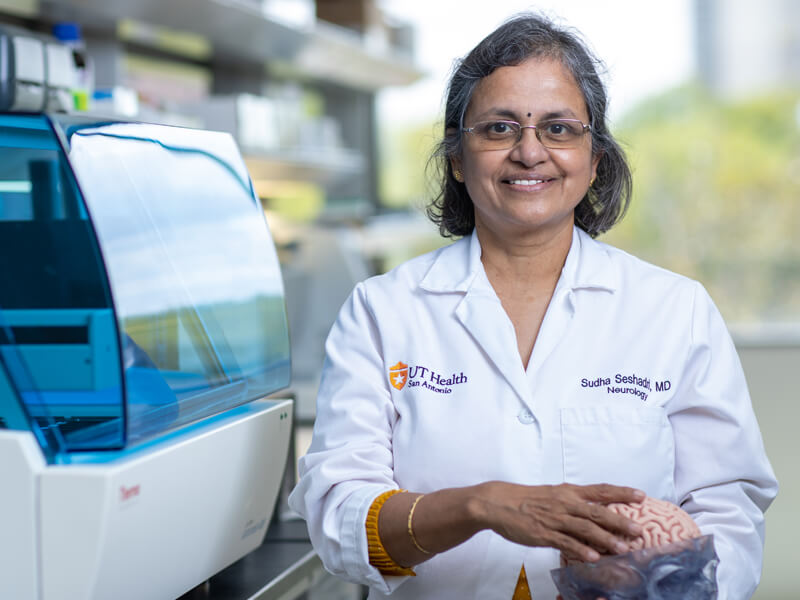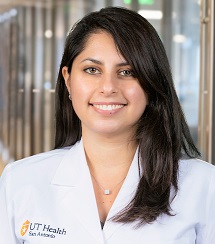Findings reported in Nature have implications for future dementia care, as well.
Contact: Will Sansom, (210) 567-2579, sansom@uthscsa.edu
SAN ANTONIO (Sept. 28, 2022) — Researchers from The University of Texas Health Science Center at San Antonio (UT Health San Antonio) are part of an international team that discovered 61 additional genetic loci associated with stroke and six genes that are potential targets for drug therapy to prevent or treat stroke. The findings, published today (Sept. 28) in Nature, are in 2.5 million people from five different ancestries, more than 200,000 of whom had a stroke. Members of the GIGASTROKE consortium conducted the research.
Stroke is the second leading cause of death worldwide, responsible for approximately 12% of total deaths, and a major contributor to years of life lost or lived with disability. Loci are the physical locations of genes on chromosomes in cells and have been called genetic street addresses.

Nature article co-author Sudha Seshadri, MD, professor of neurology in the Joe R. and Teresa Lozano Long School of Medicine at UT Health San Antonio, is founding director of the institution’s Glenn Biggs Institute for Alzheimer’s and Neurodegenerative Diseases. She leads the neurology working group of CHARGE, an international consortium that contributed to the new findings.
“The population studied in this paper has a fairly global representation including Africa, South Asia, East Asia, Europe and Latin America,” Seshadri said. “Interestingly, one of the groups that remains not very well represented is the U.S. Hispanic population, so there is still work to be done.”
Stroke is a major risk factor for dementia, and there is significant overlap between the conditions, Seshadri said. Stroke affects small vessels, endothelial cells that line blood vessels, and cells called pericytes that are important for blood vessel formation and other functions. Vascular cognitive impairment and dementia also affect small vessels, endothelial cells and pericytes, Seshadri said.

“There is common biology between stroke and dementia, and there are research methods used in this project to study stroke genetics that will make us stronger in studying dementia,” said research co-author Claudia Satizabal, PhD, assistant professor of population health sciences at UT Health San Antonio and investigator with the Glenn Biggs Institute.

Co-author Muralidharan Sargurupremraj, PhD, who worked with collaborators in Bordeaux, France, on the global initiative prior to joining the Glenn Biggs Institute, said the massive project showed the utility of using multiple methods to “move from the loci, from genetic variations, to identifying molecules and pathways that may be drug targets for stroke.”
Drug targets currently known in Alzheimer’s disease and related dementias have not led to effective therapies so far, Seshadri noted. “I really think discovering novel biology and going after it is one of the most promising avenues for finding new drug targets and medications to treat dementia,” she said.
Over the next 10 years, she said, dementia clinical care, fueled by research such as the GIGASTROKE findings, will “progress to taking a patient’s blood sample and seeing the genetics of the person, and thus understanding what is happening in the brain and doing targeted treatment.”
The Glenn Biggs Institute, in collaboration with The University of Texas Rio Grande Valley, is a National Institute on Aging-Designated Alzheimer’s Disease Research Center, one of the elite centers of dementia care and research in the U.S.
Stroke genetics informs drug discovery and risk prediction across ancestries
Authors worldwide including, from The University of Texas Health Science Center at San Antonio, Sudha Seshadri, MD; Claudia Satizabal, PhD; and Muralidharan Sargurupremraj, PhD.
First published: Sept. 28, 2022, Nature
https://www.nature.com/articles/s41586-022-05165-3
The University of Texas Health Science Center at San Antonio (UT Health San Antonio), a primary driver for San Antonio’s $42.4 billion health care and biosciences sector, is the largest research university in South Texas with an annual research portfolio of $350 million. Driving substantial economic impact with its five professional schools, a diverse workforce of more than 7,000, an annual operating budget of more than $1 billion and a clinical practice that provides more than 2 million patient visits each year, UT Health San Antonio plans to add more than 1,500 higher-wage jobs over the next five years to serve San Antonio, Bexar County and South Texas. To learn about the many ways “We make lives better®,” visit http://uthscsa.edu.
Stay connected with The University of Texas Health Science Center at San Antonio on Facebook, Twitter, LinkedIn, Instagram and YouTube.
The Glenn Biggs Institute for Alzheimer’s and Neurodegenerative Diseases is dedicated to providing comprehensive dementia care while advancing treatment through clinical trials and research. The Biggs Institute is a National Institute on Aging (NIA)-designated Alzheimer’s Disease Research Center (ADRC). In addition to patient care and research, the Biggs Institute partners with the School of Nursing at UT Health San Antonio to offer the Caring for the Caregiver program.


